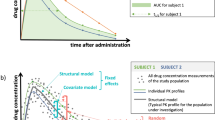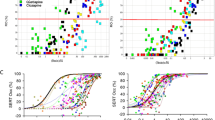Summary
Most drugs are given continuously. Clearance, the parameter which relates rate of elimination to drug concentration, is important because it defines the rate of administration required to maintain a plateau drug concentration. Together with the extent of distribution outside of plasma, clearance also determines the speed at which a drug is eliminated from the body.
The sensitivity of organ clearance of a drug to changes in binding within blood depends on its unbound clearance. If unbound clearance is low, relative to organ blood flow, the extraction ratio (and clearance) will always be low and dependent on plasma binding. If the extraction ratio is high, elimination becomes perfusion rate-limited and clearance will be relatively insensitive to changes in binding, but oral bioavailability may exhibit dependence on binding if the liver is the major eliminating organ.
A full insight into the implications of altered binding on pharmacokinetics requires a sound understanding of the physiology both of the eliminating organs and the distribution of drug within the body. Such information is steadily being acquired.
Similar content being viewed by others
References
Bass, L.; Robinson, P. and Braben, A-J.: Hepatic elimination of flowing substances: The distributed model. Journal of Theoretical Biology 72: 161–184 (1978).
Blaschke, T.F.: Protein binding and kinetics in liver disease. Clinical Pharmacokinetics 2: 32–44 (1977).
Bryson, S.M.; Lawrence, J.R.; Steele, W.H.; Campbell, B.C.; Elliott, H.L. and Sumner, D.J.: The influence of protein binding on disopyramide clearance. European Journal of Clinical Pharmacology 23: 453–456 (1982).
Forker, E.L. and Luxton, B.A.: Albumin helps mediate removal of taurocholate by the rat liver. Journal of Clinical Investigation 67: 1517–1522 (1981).
Guentert, T.W. and Øie, S.: Effect of plasma protein binding on quinidine kinetics in the rabbit. Journal of Pharmacology and Experimental Therapeutics 215: 165–171 (1980).
Gugler, R.; Shoeman, D.W.; Huffman, D.H.; Cohlinia, J.B. and Azarnoff, D.L.: Pharmacokinetics of drugs in patients with the nephrotic syndrome. Journal of Clinical Investigation 55: 1182–1186 (1975).
Hall, S.D. and Rowland, M.: Relationships between renal clearance, protein binding and urine flow for digitoxin, a compound of low clearance in the isolated perfused rat kidney. Journal of Pharmacology and Experimental Therapeutics (In press, 1983).
Higham, C; Aarons, L.J.; Holt, P.J.L.; Lynch, M. and Rowland, M.: A chronic dose-ranging study of the pharmacokinetics of phenylbutazone in rheumatoid arthritic patients. British Journal of Clinical Pharmacology 12: 123–129 (1981).
Jansen, J.A.: Influence of plasma protein binding kinetics on hepatic clearance assessed from a ‘tube’ model and a ‘well-stirred’ model. Journal of Pharmacokinetics and Biopharmaceutics 9: 15–26 (1981).
Jusko, W.J. and Gretch, M.: Plasma and tissue protein binding and pharmacokinetics. Drug Metabolism Reviews 5: 43–140 (1976).
Levy, G.: Influence of plasma protein binding on the renal clearance of drugs. Journal of Pharmaceutical Sciences 69: 482–483 (1980).
Levy, G. and Yacobi, A.: Effect of plasma protein binding on elimination of warfarin. Journal of Pharmaceutical Sciences 63: 805–806 (1974).
Meffin, P.J.; Robert, E.W.; Winkle, R.A.; Harapat, S.; Peters, F.A. and Harrison, D.C.: Role of concentration dependent plasma binding in disopyramide disposition. Journal of Pharmacokinetics and Biopharmaceutics 7: 29–46 (1979).
Øie, S.; Guentert, T.W. and Tozer, T.N.: Effect of saturable binding on the pharmacokinetics of drugs: A simulation. Journal of Pharmacy and Pharmacology 32: 471–477 (1980).
Øie, S. and Tozer, T.N.: Effect of altered plasma protein binding on apparent volume of distribution. Journal of Pharmaceutical Sciences 68: 1203–1205 (1979).
Pang, K.S. and Rowland, M.: Hepatic clearance of drugs. 1. Theoretical considerations of a ‘well-stirred’ model and a ‘parallel tube’ model. Influence of hepatic blood flow, plasma and blood cell binding, and the hepatocellular enzymatic activity on hepatic drug clearance. Journal of Pharmacokinetics and Biopharmaceutics 5: 625–653 (1977).
Rowland, M.; Leitch, D.S.; Fleming, G. and Smith, B.: Protein binding and hepatic extraction of diazepam across the rat liver. Journal of Pharmacy and Pharmacology 35: 383–384 (1983).
Rowland, M. and Tozer, T.N. (Eds): Clinical Pharmacokinetics — Concepts and Applications, pp. 48–64 (Lea and Febiger, Philadelphia 1980).
Schary, W.L. and Rowland, M.: Protein binding and hepatic clearance: Studies with tolbutamide, a drug of low intrinsic clearance, in the isolated perfused rat liver preparation. Journal of Pharmacokinetics and Biopharmaceutics 11: 225–243 (1983).
Shand, D.G.; Cotham, R.H. and Wilkinson, G.R.: Perfusion-limited effects of plasma drug binding on hepatic drug extraction. Life Sciences 19: 125–130 (1976).
Tang-Liu, D.D.-S.; Tozer, T.N. and Riegelman, S.: Dependence of renal clearance on urine flow: A mathematical model and its application. Journal of Pharmaceutical Sciences 72: 154–158 (1983).
Tozer, T.N.: Concepts basic to pharmacokinetics. Pharmacology and Therapeutics 12: 109–132 (1981).
Trenk, D. and Jähnchen, E.: Effect of serum protein binding on pharmacokinetics and anticoagulant activity of phenprocoumon in rats. Journal of Pharmacokinetics and Biopharma-ceutics 8: 177–191 (1980).
Wilkinson, G.R. and Shand, D.G.: Commentary — A physiological approach to hepatic drug clearance. Clinical Pharmacology and Therapeutics 18: 377–390 (1975).
Winkler, K.; Keiding, S. and Tygstrup, N.: Clearance as a quantitative measure of liver function; in Paumgartners and Presig (Eds) The Liver: Quantitative Aspects of Structure and Functions, pp. 145–155 (Karger, Basel 1973).
Author information
Authors and Affiliations
Rights and permissions
About this article
Cite this article
Rowland, M. Protein Binding and Drug Clearance. Clin Pharmacokinet 9 (Suppl 1), 10–17 (1984). https://doi.org/10.2165/00003088-198400091-00002
Published:
Issue Date:
DOI: https://doi.org/10.2165/00003088-198400091-00002




